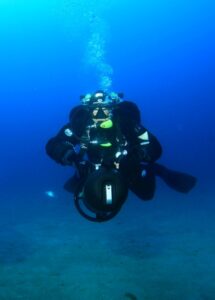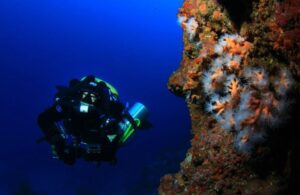General information about autonomous scuba diving
Overview
Autonomous scuba (Self-Contained Underwater Breathing Apparatus) diving can be defined as all variants of diving in which the required breathing gas is carried by the diver himself. It differs fundamentally from surface-supported diving, in which the diver is permanently connected by an umbilical cord to the supply station located on the surface, usually in the form of a diving supply ship. The diver is supplied by this – among other things – with a breathing gas adapted to the diving depth, has voice communication with the surface station and can be lowered into the depth at the umbilical cord and brought back to the surface.
Autonomous diving equipment is divided into open (Open Circuit – OC) and closed (Closed Circuit CC) or semi-closed (Semi-Closed – SC) systems. The best known is the open system, in which the diver is supplied with breathing gas from one or more compressed gas cylinders via a regulator during his dive. The entire amount of gas breathed is released directly into the surrounding water when exhaled. In a closed system, which is also known as an autonomous regeneration diving device or closed-circuit rebreather, or CCR for short, the exhaled breathing gas is not released into the surrounding water, but is regenerated within a closed circuit and inhaled again. The semi-closed rebreather, or also Semi-Closed-Rebreather, short SCR, represents to a certain extent an intermediate form of open and closed system.

Regarding the maximum dive depth and dive time, a distinction must be made between normal recreational diving and technical diving. Basically, recreational diving is carried out at depths up to a maximum of 40 meters. As a rule, compressed air or compressed air enriched with up to 40% oxygen is used, so-called Nitrox. The key point is that all dives are carried out within the “no decompression time”. As the depth increases, the maximum duration of a dive within which it is possible to ascend directly to the surface without stopping. If this “no-decompression limit” is exceeded, the diver must gradually ascend to the surface. It is mandatory to make decompression stops, this is called technical or decompression diving. The total duration of these decompression stops increases disproportionately with the maximum depth and the time spent underwater. Dives beyond a depth of about 50 m are always subject to decompression regardless of the dive time. For physiological and physical reasons, air or nitrox is no longer a breathing gas at this depth. From this depth on Trimix is used, which usually consists of a mixture of oxygen, nitrogen and helium. Due to the ambient pressure, which increases with the dive depth, the breathing gas consumption increases proportionally. The technical diver with open system is therefore forced with increasing depth and the associated decompression obligation to carry an adequate amount of different mixed gases. To illustrate this point, one can imagine that, in addition to a considerable amount of safety and emergency equipment, a dive to e.g. 100 meters and a duration of 15 minutes at this depth would require a corresponding amount of 18,000 liters of breathing gas to be carried on the surface. This means that the diver has to carry up to 6 compressed gas cylinders, which together with the rest of the equipment can quickly reach 100 kg.
Rebreather
As an alternative to the open system, an autonomous rebreather, also known as an autonomous regeneration submersible or Closed Circuit Rebreather (CCR), can be used. Due to its special function, the carbon dioxide (CO2) produced by the metabolism of the diver is constantly filtered out in a closed circuit rebreather or the oxygen used is added again. Therefore, almost no breathing gas – especially the expensive helium – is wasted or released into the water. For the same dive less than 10 % of the gas volume is used.

The weight of the required equipment is reduced to about 50 kg. Further decisive physiological advantages compared to the open system are a flowing adjustment of the mixed gas to the respective diving depth, a higher breathing gas temperature and a resulting lower cooling of the diver as well as a significantly lower dehydration. Regarding the application, a distinction must be made between mixed gas rebreathers for technical divers in decompression diving and air/nitrox rebreathers for recreational divers1 in “no decompression” diving. Technical decompression diving with mixed gas rebreathers is the top class of autonomous scuba diving.
Advantages and disadvantages
The main advantages of a CCR include
• Significantly lower consumption of breathing gases (usually helium, oxygen, nitrogen)
• Longer dive times
• Physiologically compatible breathing gas temperature and water vapour saturation
• Ideal flowing breathing gas composition adapted to the respective diving depth
• Almost noiseless and no signature due to gas bubbles in the water
• No gas accumulation on cave ceilings or in wrecks
• Largely variable dive profiles with regard to dive depth and time
The main disadvantages of most currently available CCRs are
• Unreliable oxygen partial pressure sensor
• Complicated error-prone machine control and monitoring
• Lack of redundancy of critical machine parts therefore forces necessary bail-out2
• Insufficient manual oxygen supply (no depth-independent clear amount of substance)
• Increased work of breathing (compared to OC)
• Maximum operating depth of 100 m
Further information about Technical Diving and Diving Rebreather, Rebreather Diving, Rebreather
